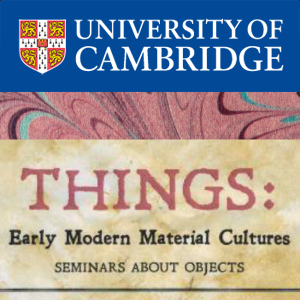Things - 25 February 2015 - Postcolonial Things
Duration: 35 mins 13 secs
Share this media item:
Embed this media item:
Embed this media item:
About this item

| Description: |
Dr Robbie Richardson (English, University of Kent)
“[T]he most mysterious thing in the World”: British Interpretations of First Nations Material Culture Abstract This paper will look at the relationship between British people in the eighteenth century and the North American cultural objects that they privately collected or viewed in museums, cabinets of curiosities, coffeehouses, and other venues. More specifically it will look at the body of First Nations material culture that arrived in large amounts throughout the century and the ways that these objects shaped British perceptions of Native people and their own sense of identity. There has been little scholarship on the ways in which this material, imbued with First Nations skill, knowledge, and memory, was perceived by British people and interacted with other forms of representation in print and visual culture. While we must remember, as Susan Stewart suggests, that cultural objects in collections “are naturalized by the erasure of labor and the erasure of context of production,” at the same time wampum, calumets, and tomahawks were regularly written into fictional texts and came to be understood for both their physical appearance and symbolic functions; furthermore, they became metonymic for Indians, whose perceived fetishistic relationship to their own material culture both reflected on and critiqued British consumer culture. |
|---|
| Created: | 2015-03-05 10:54 |
|---|---|
| Collection: | Things Seminar |
| Publisher: | University of Cambridge |
| Copyright: | Glenn Jobson |
| Language: | eng (English) |
| Keywords: | CRASSH; Things; Robbie Richardson; |
| Abstract: | Dr Robbie Richardson (English, University of Kent)
“[T]he most mysterious thing in the World”: British Interpretations of First Nations Material Culture Abstract This paper will look at the relationship between British people in the eighteenth century and the North American cultural objects that they privately collected or viewed in museums, cabinets of curiosities, coffeehouses, and other venues. More specifically it will look at the body of First Nations material culture that arrived in large amounts throughout the century and the ways that these objects shaped British perceptions of Native people and their own sense of identity. There has been little scholarship on the ways in which this material, imbued with First Nations skill, knowledge, and memory, was perceived by British people and interacted with other forms of representation in print and visual culture. While we must remember, as Susan Stewart suggests, that cultural objects in collections “are naturalized by the erasure of labor and the erasure of context of production,” at the same time wampum, calumets, and tomahawks were regularly written into fictional texts and came to be understood for both their physical appearance and symbolic functions; furthermore, they became metonymic for Indians, whose perceived fetishistic relationship to their own material culture both reflected on and critiqued British consumer culture. |
|---|---|

